
 |
| Whenever Japanese junior high and high school students are called upon to introduce themselves, they invariably mention the school sport or activity clubs to which they belong. School club activities start as a part of formal curriculum from fifth and sixth grades of elementary school. In junior high schools there are two types of club activities -- those that are part of the formal curriculum and are compulsory, and extracurricular clubs which are optional. The latter are more active in high schools. One survey* shows that more than sixty percent of high school students in Japan take part in a school club of some type. The clubs provide opportunities for students to enjoy their hobbies, improve particular skills, and discipline themselves in the process. For many students, clubs are even more important as a way to get to know students in different classes or grades and forge lasting friendships. In this issue, We look at high school club activities -- how they are organized, what they mean to the students, and so on -- as depicted in photographs and captions submitted to the TJF's Daily Lives of Japanese High School Students Photograph Contest. *  [ Survey on the Daily Lives of Junior High and High School Students ],Japan Youth Research Institute, 2000. |
|
School Clubs in Overview Japanese high schools typically offer students a variety of sports, humanities-related, science-related and arts clubs. According to the survey mentioned above, 34.5 percent of high school students join sports clubs, 24.5 percent humanities-related and other clubs, and 1.4 percent both kinds, while 39.4 percent do not take part in any school clubs. 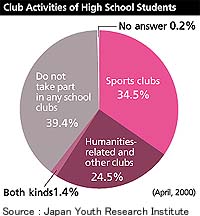
 In order to fulfill specific educational policies or create a distinctive school image, some schools emphasize particular kinds of clubs. For example, some schools seek to strengthen their athletics clubs by attracting suitably talented students from all over the country under a recommendation-based enrollment system. Of course, there are also many students who prefer to pursue interests outside school rather than join a school club, as well as schools where club activities in general are not very popular. In order to fulfill specific educational policies or create a distinctive school image, some schools emphasize particular kinds of clubs. For example, some schools seek to strengthen their athletics clubs by attracting suitably talented students from all over the country under a recommendation-based enrollment system. Of course, there are also many students who prefer to pursue interests outside school rather than join a school club, as well as schools where club activities in general are not very popular. At most schools, clubs are classified as extracurricular activities. Essentially they are managed by the students themselves, led by a club president supported by other club officers such as vice-president and manager. Normally club presidents are students in the higher grades. Guidance is usually given by members of the school teaching staff acting as supervisors or coaches, and sometimes by ex-members-third-year students or graduates who visit their old clubs for practice. Clubs also include representatives from the teaching staff who act as advisors, act as liaisons between the club and the school authorities, and supervise the club's other external affairs. At most schools, clubs are classified as extracurricular activities. Essentially they are managed by the students themselves, led by a club president supported by other club officers such as vice-president and manager. Normally club presidents are students in the higher grades. Guidance is usually given by members of the school teaching staff acting as supervisors or coaches, and sometimes by ex-members-third-year students or graduates who visit their old clubs for practice. Clubs also include representatives from the teaching staff who act as advisors, act as liaisons between the club and the school authorities, and supervise the club's other external affairs. School clubs vary widely in size. While some have only a few students, others, such as sports clubs that have achieved national renown, can attract over a hundred members at a time. School clubs vary widely in size. While some have only a few students, others, such as sports clubs that have achieved national renown, can attract over a hundred members at a time.
|
 |
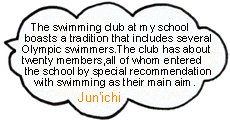 |
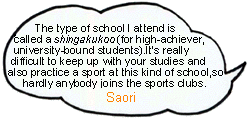 |
 |
  |
|||
|
A Chance to Absorb Yourself in Something In another survey*, respondents were asked what they felt were the most rewarding times at school. The second most common response, after "when spending time with close friends" (53.1%), was "when involved in student council, club or other group activities " (16.1%). When the same question was put to American and Chinese high school students, although the most common response was the same as for Japanese students, in both cases the second most common response was "when taking lessons that I like," with "student council, club activities, etc." ranking third or lower. These results suggest that for Japanese high school students club activities play a particularly important role in school life. *  [ Survey on Sports and Health: A Comparison of Japanese, American and Chinese High School Students ], Japan Youth Research Institute, 1996. |
 |
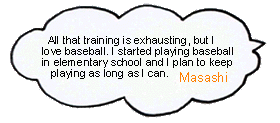 |
  |
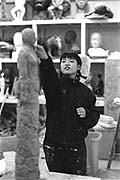 Photo : Yamaguchi Yuko |
 Every one of her creations is based on a sketch. Here, she' s agonizing over one of her sketches in an effort to improve on it. |
|||
|
A Place to Build Relationships While the atmosphere of Japanese school clubs varies from club to club, there persists a traditional image, particularly in strict sports clubs, of senpai ( upper-grade students )* lording it over their koohai ( lower-grade students )*. In clubs that keep such old-fashioned ways, first-year students often have a long initiation period of basic training, performing menial tasks such as gathering up balls and generally learning the ropes. These days, however, this "rank" style of social interaction is dying out, and school clubs are becoming more relaxed places for making friends with students from other grades and meeting people who will offer various kinds of advice and guidance. Clubs also provide opportunities for students to learn about social interaction in general, such as by allowing them to develop interpersonal ties through group activities; through tasks such as teaching others and planning courses of action from a broad perspective; and through experiences such as training camps and inter-school matches. |
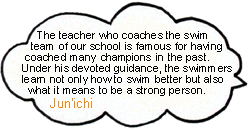 |
 |
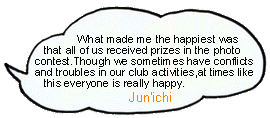 |
  |
Photo : Murata Asami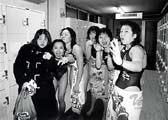 In the locker room after training. With the conversation bouncing along, everyone has such a good time they forget how exhausted they are from practice. |
|
Photo : Shima Akiko My friend is a long-distance runner in our school's track and field club. Famished after all the training, she stops by a noodle shop on the way home for her favorite, miso raamen.** |
||
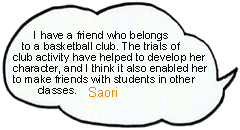  |
||
*  (senpai) Someone in a higher academic level or more advanced / superior position than you in a given discipline or pursuit. Someone who entered the school, university, or place of employment before you did. This term is widely used in clubs and other areas of Japanese junior high and high school life. The term senpai is used to mean seniors in general, but it is also used to refer to individuals with the person's name -- usually their surname but sometimes their first name -- plus "senpai," as in "Tamura-senpai" or "Yuki-senpai." The corresponding word for students / people in lower grades / positions is koohai (senpai) Someone in a higher academic level or more advanced / superior position than you in a given discipline or pursuit. Someone who entered the school, university, or place of employment before you did. This term is widely used in clubs and other areas of Japanese junior high and high school life. The term senpai is used to mean seniors in general, but it is also used to refer to individuals with the person's name -- usually their surname but sometimes their first name -- plus "senpai," as in "Tamura-senpai" or "Yuki-senpai." The corresponding word for students / people in lower grades / positions is koohai  , though this is not used in conjunction with surnames or other names to refer to those people. , though this is not used in conjunction with surnames or other names to refer to those people.
** miso raamen: Raamen is noodles made of wheat flour, eaten in a hot broth with meat and vegetables. Raamen with miso in the broth is miso raamen. One serving costs about  600. 600. |
|
Links to Society at Large In many fields of school club activity, national competitions, and concerts, performances and other events are held to allow clubs to compete with one another or present the results of their training or studies. Sport clubs focus on practice matches and official inter-school matches. While the system of official matches varies from sport to sport, in most cases the third-year students retire after an important match or tournament, making way for the next round of matches featuring new and promoted club members. ( Note that the Japanese school year begins in spring -- in April -- so this is usually when clubs take in new members. ) Sport clubs also play intra-club matches as red and white teams, as well as matches against alumni teams. The national "inter-high" tournaments in sports such as baseball ( see the column below ), soccer and rugby are televised and enjoy considerable popularity among the general public. Most schools also hold an annual bunkasai or school festival as another important occasion for school clubs, particularly performance and humanities and arts-related clubs, to show their talents to wider audience. |
Photo : Arai Keisuke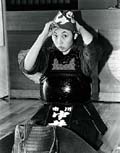 |
She's in her kendo gear, preparing for a practice match with students from another school. Putting on her helmet, she concentrates on the match. | Photo : Soejima Sachi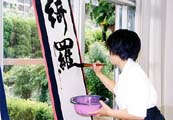 My friend belongs to the calligraphy club. Wearing traditional hakama and kimono, she executed a work of calligraphy before an audience at bunkasai. |
|
Club Practice Times and Content At most schools, club activities are held after school. Each club determines which days of the week it will hold practice or training sessions. Most clubs practice for two or three hours after school, though a few opt for morning sessions ( called asa-ren ). In sports and athletics clubs, practice matches and official matches are held on weekends and holidays. During summer vacation, some clubs hold training camps ( about a week long ) or other intensive practice / activity sessions. Training camps may consist of overnight stays at the school or trips to summer retreats or other facilities equipped for the particular club's activities.  Some high school students devote almost all their non-class time to club activities. In many cases, especially among junior high and high school students in sports and athletic clubs, club practice time can seriously encroach on the time they need to study. Some see this situation as a good opportunity for students to learn how to use time wisely, coordinating their club and study schedules for best results in both. Some high school students devote almost all their non-class time to club activities. In many cases, especially among junior high and high school students in sports and athletic clubs, club practice time can seriously encroach on the time they need to study. Some see this situation as a good opportunity for students to learn how to use time wisely, coordinating their club and study schedules for best results in both.
|
|
All-Japan High School Baseball Championship Tournament The national baseball tournament contested by high schools with baseball clubs throughout Japan is sponsored by the national daily newspaper, Asahi shimbun. Finals are held at the Kooshien Baseball Stadium in Hyoogo prefecture in August. Since its inception in 1915, and despite suspension during the Pacific War, the tournament has grown year after year and now enjoys immense popularity as a national annual event. Qualifying matches are held in each prefecture -- in 2000 a total of 4,119 schools competed in the 82nd tournament -- after which the top 49 schools ( one from each prefecture plus an extra one each from Tokyo and Hokkaido, -- which have two qualifying districts ) vie for the championship at Kooshien stadium. Even making it to the finals is a great honor, and it is not uncommon for competing schools and their local communities to turn out at the stadium in several busloads to cheer their teams. Many professional baseball players in Japan are scouted from high school teams that played at Kooshien. ( Another national high school baseball tournament, sponsored by the national daily, Mainichi shimbun, is held at Kooshien in the spring. ) |
|
Activities for Japanese-language Class The club activities of Japanese schools probably differ in many respects from those of your school. From a broader perspective, however, the phenomenon of young people pursuing such activities in order to practice special skills, make friends, and learn to interact with the society around them is common to all countries. We hope the information about Japanese school clubs provided here will prompt readers to think about clubs in various ways : why do club activities differ from country to country ( if they do )? What possible alternatives to clubs are available to young people in your country? You could also explore this topic by discussing the kinds of extracurricular activities your students get passionate about, why they do,and what they get out of them. |
|
Activity 1: Draw a line from each club name to the corresponding illustration. ( Objective : A warm-up activity to familiarize students with vocabulary they will need when talking about their own club activities. ) The ten most popular school club activities among Japanese high school students ( source: Japan Youth Research Institute ) : |
|
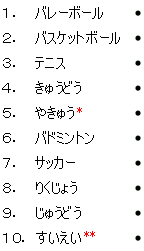 * Hint :  means "field," means "field,"  means "ball" means "ball"** Hint :  means "water" means "water"
|
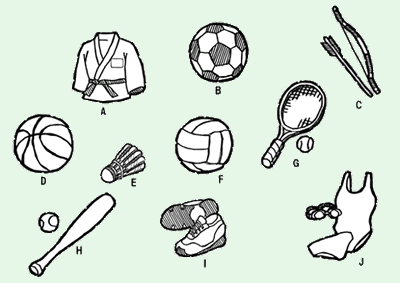 click here for the answers |
|
Activity 2: You have received a letter of self-introduction from a high school student at a sister school in Japan and are going to write a reply. Your letter may include information such as whether or not your school has club activities;whether or not you belong to any clubs and if so which one;what other things you are especially interested in if you are not in a school club and why. ( Objective: To gain an understanding of Japanese school clubs and to think and write about corresponding activities in one's own life. ) |
|
 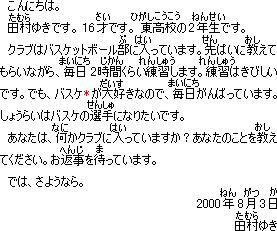
|
Hello. My name is Tamura Yuki. I am 16 years old and am a second-year student at Higashi High School.  I am a member of my school's basketball club. We practice for about two hours every day,with our senpai acting as coaches. The practices are pretty tough, but I stick with it every day because I really like basketball a lot. I hope to become a professional basketball player some day. I am a member of my school's basketball club. We practice for about two hours every day,with our senpai acting as coaches. The practices are pretty tough, but I stick with it every day because I really like basketball a lot. I hope to become a professional basketball player some day. Do you belong to any school club? Please tell me something about yourself. I'm looking forward to your reply. Do you belong to any school club? Please tell me something about yourself. I'm looking forward to your reply. Bye for now. Bye for now. Tamura Yuki Tamura Yuki 3 August 2000 3 August 2000 |
 * * : An abbreviation of : An abbreviation of 
| |
|
Activity 3: If you were to spend a year at a school in Japan... (a)   Would you join a school club? Would you join a school club?(b)   What club would you join? What club would you join?(c)   Why would you pick that club? Why would you pick that club?
|
Compare your responses to those of your classmates. The class could then hold a vote to see which clubs are the most popular. ( Note that, when counting the results of a vote, the tally can be kept using the kanji character  instead of instead of  . ) . )( Objective: To simulate moving from one's own culture into a different culture and choosing a course of action based on an understanding of that culture. ) |
| answers |
||||
| 1. F ( volleyball ) | 2. D ( basketball ) | 3. G ( tennis ) | 4. C ( kyuudoo ) | 5. H ( baseball ) |
| 6. E ( badminton ) | 7. B ( soccer ) | 8. I ( track and field ) | 9. A ( judo ) | 10. J ( swimming ) |
Original text : The Japan Forum Newsletter no18 "A day in The Life" September 2000.
Send feedback to forum@tjf.or.jp